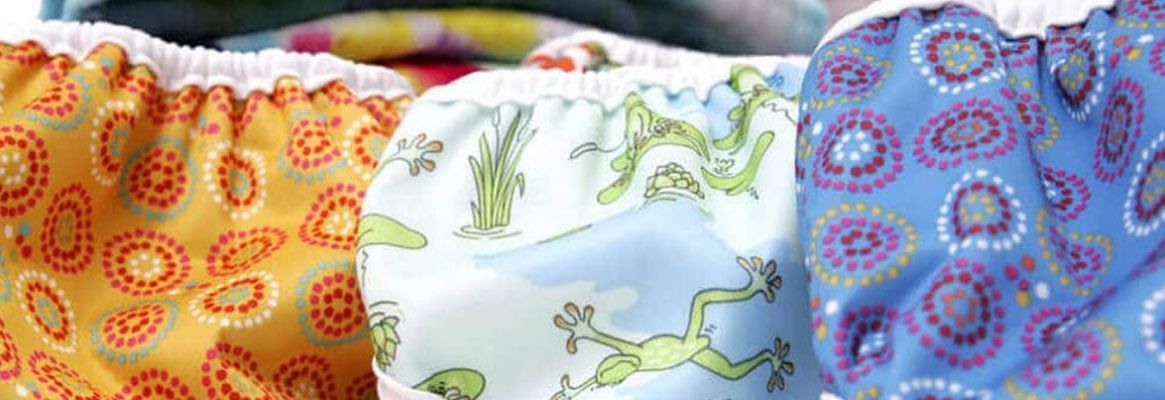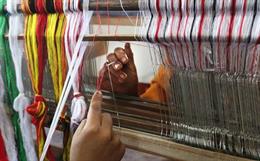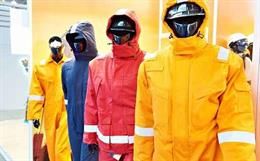Introduction:
A diaper or nappy is an absorbent garment worn byindividuals who are
- Incontinent (i.e., who lacks control over bladder or bowel movements)
- Unable to reach the toilet when needed.
This group primarily includes infants and young children, someelderly people, some with a physical or mental disability, people working inextreme conditions (e.g. astronauts) and also for pet animals. Mostly diapersare used for kids until they are potty trained, and also by adults who areincontinent/sick.
Disposable diapers are mostly made using thefollowing components and materials:
Among all parts, four are very essential layersin a diaper (shown in Fig-1.).
Fig-2. Diaper Picture Top view
Polythene film (Back sheet):
This is the back/bottom-most sheet of a typical disposable diaper. They are hydrophobic nonwoven films. This part of diaper is impermeable to liquid (i.e.urine). Some times polypropylene films may also be used. This part is responsible for preventing the urine from escaping through the diapers.
Breathable/Cloth-like back sheet:
Sometimes this polyethylene back sheet is given breathable/cloth-like look using a thin polypropylene nonwoven sheet. This process is done by using either the hot melt process or the heat and pressure method with direct extrusion to the nonwoven.
Cloth-like back sheet of disposable diapers are not really made of woven cloths, but this is really made with the polypropylene non-woven films.
Polypropylene Nonwoven (Top sheet and Leak guard):
Both Hydrophobic and Hydrophilic polypropylene non-woven sheets (shown in Fig-3) are used in disposable diapers. Philic means permeable to water and phobic means impermeable to water.
Hydrophobic polypropylene nonwovens are impermeable to liquids, and this is used in crotch region as leak guards (shown in Fig-2.). This feature is designed to prevent leakage through leg cuff area of diaper.
Hydrophilic polypropylene nonwovens are the liquid permeable top layer that comes in contact with the baby's skin (this is indicated by light orange colour in Fig-1.). This part allows the urine to pass through it and reach the absorbent core.
Most nonwovens used in diapers are made with the spun bonding process, which has good tensile strength and abrasive resistance. It is possible to use thermal bonded nonwovens also, as they are softer but they have lower resistance and strength. Trough Air Bonded nonwovens which are more lofty, can also be used.
Fig-3. Spun Bonded Polypropylene Nonwovens
Absorbent core - Wood pulp fluff:
Wood pulp fluff (shown in Fig-4.) is cellulose which is used as the core of the diaper to absorb liquids. It gives good absorbing capacity to the diaper. The pulp has qualities such as high ratio of fibres to weight, lower coarseness and shorter fiber length. It is also homogenous and uniform short fiber.
The capacity of normal wood pulp fluff is around 10 cc of water per gram of pulp when the diaper is not under pressure. But when subjected to 5 KPa of pressure its capacity becomes less than 2cc. Hence super absorbent polymer is also needed to hold the liquids under pressure.
These wood pulp sheets come from pine trees, which are generally obtained from the forests. Immediate absorption of wood pulp fluff is the reason for its usage in the disposable diapers. Liquids are absorbed in the void spaces between the fibres known as capillaries and it is also due to the surface tension angle between the water and the fibres. Typical fiber length for wood pulp fibres used in diapers is about 2.6 mm.
An alternative core material to this wood pulp is to use air laid synthetic fibres. But still it is difficult for air laid synthetics to compete with pulp. Cellulose acetate, the material which is used in cigarette filters, are also used in some absorbent products. Polypropylene fibres are also tried for absorbent core formation.
Fig-4. Diaper Absorbent Core Wood Pulp Fluff
Super Absorbent Polymer (SAP):
Super Absorbent Polymer or SAP is also known as Super Absorbent Material or SAM (shown in Fig-5.). It is used in the form of fine granules (like table salt). It increases the retention capacity in a baby diaper. Thus helps to get the product to be thinner with good performance and less usage of wood pulp fibres. Chemical commonly used as SAP is sodium polyacrylate. When the SAP comes in contact with water, the sodium detaches itself, leaving only carboxyl ions. These carboxyl ions are negatively charged, hence they repel each other. Due to this SAP polymer unwinds and absorbs water, which is attracted by the sodium ions.
Now the polymer with water becomes gel, this is due to the cross-links which effectively leads to a three-dimensional structure and also due to its high molecular weight (i.e., above a million). Because of the polarity forces between the atoms, the hydrogen in the water (H-O-H) is trapped by the acrylate.
The super absorbent properties of SAP is affected by the electrolytes in the liquid, (urine contains 0.9% of mineral electrolytes), because they reduce polarity. Thus it will affect the super absorbent capacity which is required for liquid retention. So the diapers with SAP should never be tested with plain water, but with 0.9% saline solution.
Fig-5. Super Absorbent Polymer (SAP)
The SAP is available in two different varieties. First type absorbs either higher amounts of liquids but has less retention and the other type absorbs lower amount of liquids but has very high retentions. It can be chosen according to requirement and desire. Mostly high capacity SAPs are used in diapers. Also, a surface cross linker can be added to the SAP polymer so that it will help to move the liquids during saturation and prevent gel blocks formation. This is because of the phenomenon that it is impossible to move the liquids once a SAP gets saturated.
Elastics:
Usually polyurethane or polyester foam elastics, and synthetic rubber or Lycra/ Spandex elastics are used in disposable diapers. Mostly spandex elastics are used nowadays. Spandex elastics are soft and are also high efficient elastics. These elastics will stretch as much as 400% of its original length before it breaks. But it is used in diapers at lesser than 300% stretch only. They are used in leg cuff area, and also near the waist to give a better fit to thighs and hip of the baby.
The elastics may also be used at the side panels and also near the fastening tape area, to provide elasticity even at the fastening zone of the diaper. New generations of softer and stronger elastic materials are emerging to be used in diapers.
Fig-6a. Elastics at waist and leg cuffs, ADL
Fig-6b. Elastic at side panels of fastening tape
Quick wicking layer / Acquisition and Distribution Layer (ADL):
They are also known as Acquisition and Distribution Layer abbreviated as ADL. It is a intermediate layer used between the top polypropylene nonwoven sheet and the absorbent core (ADL is shown in Fig-6a., and 7). These may be used in full length or as a patch near the urine deposit zone. This layer gets significance only in thin/ultra thin Diapers, due to its property of moving the liquids quickly into the absorbent core and hence reducing the potential leakage.
The ADL gives some dry feel to the skin, because it provides an additional separation between the wet pad and the skin. ADL's are made of either trough air bond (TAB) nonwovens or of an aperture sheet (i.e.,made of perforated plastic film). Cheaper diapers may sometimes use the resin bonded nonwovens, but they give poor performance when compared to TAB nonwovens.
Fig-7. Quick wicking layer / Acquisition and Distribution Layer (ADL)
Hot Melts Adhesive:
The diaper components are usually joined with these adhesives. These are mostly a mixture of resins, oils and tackifiers. The hot melt adhesives are applied in molten form and when it cools down it gives a better bonding force to join the parts of diaper. Two types of adhesives are used in the disposable diapers. They are a construction adhesive, and an elastomeric adhesive. The construction adhesive is used to glue the back sheet and the nonwovens. The elastomeric adhesive is used to glue the leg and waist foam elastics with the nonwovens. The elastomeric adhesive has higher elasticity and bonding strength and also it is more expensive than construction adhesives. The ultra thin diapers need some extra joint effect at the wet core, so a special pad integrity adhesive is used to serve this purpose.
Fig-8. Hot melt gluing of Lycra elastic with Polypropylene nonwoven
Fastening Tapes:
Generally fastener tapes used in diapers are either velcro tape type fasteners or stick tape type fasteners. Velcro (shown in Fig-9.) tape will give a good mechanical grip, which is also known as the "hook & loop fasteners". These Velcro tapes use lock loops and brush loops to give a soft but strong closure.
Sticker tape is usually made of sticky polypropylene lateral tape which is closed to the polypropylene frontal tape (it may have a printed design for attraction). This sticker tape is economical than the Velcro tape.
There are new versions of elasticized nonwoven Velcro tapes emerging to be used in diapers. Nowadays diapers are replacing with the new stretchable fastening systems that offer the same characteristics but less cost.
Fig-9. Hook & Loop fasteners
Fig-9a. Hook system enlarged
Fig-9b. Looping system enlarged
Moisturizing and Fragrant lotions:
Nowadays several topical lotions are added to the nonwoven top sheet in order to create some product differentiation in market. Some of them are Aloe Vera, Vitamin E, Petrolatum, Almond Oil, Vitamin D, Oat Extract, Jojoba, etc. There is also another trend to use antibacterial lotions such as tertiary ammonia or silver salt compounds.
Fig-10. A Typical Disposable Diaper with its significant parts labeled
Fig-10 shows the components of the commercially available disposable baby diapers, and also their purposes and properties are briefly discussed above. In future there is very good scope for these hygiene nappies to be subjected for several design or technological changes, thus making easy handling for the consumer. Also comfort and safety requirements will enhance the demand for ecofriendly and environment friendly diapers in upcoming days.
References:
- McAloney, Regina. "Thin is in." Nonwovens Industry, November 1994 p.52.
- Ohmura, Kin. "Superabsorbent Polymers in Japan." Nonwovens Industry, January 1995, p. 32.
- Lenzner, Robert, and Carrie Shooc. "The Battle of the Bottoms." Forbes, March 24, 1997, p. 98.
- A.M. Cottenden, P.H. Thornburn, Wet Comfort of Small Disposable Incontinence Pads, G.E. Dean, M.J. Fader, and R.J. Brooks, Textile Research Journal, 7 1998; vol. 68: pp. 479 - 487.
- www.nonwovens-report.com
- www.disposablediaper.net
- www.babynaturale.com
- www.mothering.com
- www.freepatentsonline.com
About the Author:
The author is in the Final Year of M.Tech (Apparel Technology and Management) in Kumaraguru College of Technology, Coimbatore.
To read more articles on Textile, Industry, Technical Textile, Dyes & Chemicals, Machinery, Fashion, Apparel, Technology, Retail, Leather, Footwear & Jewellery, Software and General please visit http://articles.fibre2fashion.com
To promote your company, product and services via promotional article, follow
this link: http://www.fibre2fashion.com/services/article-writing-service/content-promotion-services.asp







